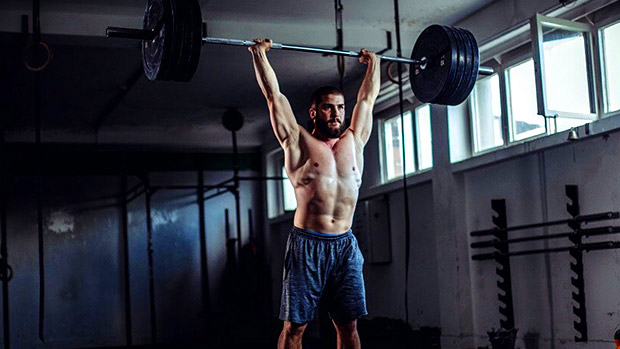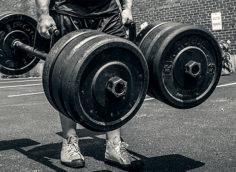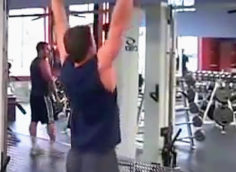The barbell shoulder press is a staple of strength and muscle building, but most lifters do it wrong.
Consider that the humeral head is classified into three types: Type A (smooth), Type B (curved), and Type C (hooked). Your type determines which press you'll be capable of doing correctly. We don't need to get into how to classify yourself, but suffice it to say, performing an overhead variation for eight weeks that causes you to get injured doesn't really help.
No worries, though. Here are five progressions and some important identifiers to help you learn your deficiencies and ultimately build muscle safely.
This press is simple and allows you to choose the angle through which you press the bar overhead. Set up with one knee down and your back toe dug into the ground. This will help you contract your glute and keep your pelvis under you throughout the press.
Start by pressing up as if it's an incline press, and then bring your chest forward to match the angle of the bar. In the finished position, your biceps should be next to your ear.
Continue using this variation until you can press overhead without any curvature in your lower back and there's a straight line from the bar through your shoulder, hip, and down to your knee.
With this one, your chest angle will be upright, causing you to bear more of the weight through your spine.
With the kettlebell upside down, this variation forces you to use all of your stabilizer muscles, resulting in a more proficient movement. Press the kettlebell directly overhead so that once your arm is fully extended, your bicep is next to your ear and there's a straight vertical line from the top of the kettlebell to the ground.
Use this lift until you can press 15-20% of your bodyweight perfectly for 5 reps.
Adding another knee to the ground and another arm overhead changes the lift completely. This is where it'll become more obvious if you have some mechanical issues. Adding a second arm demands more mobility and strength from your T-spine to press overhead into the proper position.
As you press, squeeze your glutes and core to maintain your pelvic position. If you lose your pelvic position, the stress will transfer to your lower back.
Finish the lift with both dumbbells directly overhead while maintaining a straight line from the dumbbell to the ground. Once you can properly press 35 pounds in each hand, you'll be ready to move on to using the 45-pound Olympic bar. Two 35-pound dumbbells equal a total of 70 pounds, which is 1.5 times the weight of the Olympic bar, and that formula is a good predictor of success with the bar.
It's time to move from kneeling to standing, which creates a longer lever arm. This is great if you know how to press, but bad if you don't. But now you have an understanding of where your pelvis needs to be in order for your spine and core to contract optimally.
The barbell is a fixed implement, which means your limbs must move together. If either arm lacks mobility or strength, you'll either compensate with your lower back or you won't be able to lock the bar overhead.
The lift starts with your feet, so root your feet into the ground, lock out your knees, and engage your glutes. As you press the bar from the front rack position, your chin must move slightly back to allow the bar to travel straight up while still maintaining posture. Once the bar passes your head, push your head forward so the bar is directly over your head.
Keep progressing with this movement until you can press 80% of your bodyweight with perfect form.
The Z Press, done seated and with the legs outstretched, is the ultimate exercise to test your ability to keep your posture while pressing something overhead. Sitting with your legs straight out forces you to develop a considerable amount of hamstring flexibility, along with the requisite core tension to remain upright.
As you press up, keep the implement stacked over your shoulder and hips until the finished position. Start with a landmine, progress to a kettlebell, then a dumbbell, and finally to a barbell.
Most people have a false perception of where they are on the progression, but choosing the exercise that allows you to press through a full range of motion without compensation will put you in the position to grow. If you reach a progression that you struggle with, try using these mobility exercises to get past your sticking point:
Alternating Handcuff Drill
This mobility drill allows you to work through end ranges of motion while keeping your spine in line and only focusing on one arm being overhead. Perform the exercise slowly and challenge yourself through the tough sticking points.
Handcuff Drill
This exercise exposes all of your weaknesses. If you're struggling to get your hands behind your back or extended overhead, you're not prepared to press a barbell overhead. Keep working at this drill until you are.
Ring Press-Up
Strength is transferred proficiently through full body tension, and keeping your core intact while pressing your hands overhead requires the proper core stability and thoracic strength capacity to perform any variation of the overhead press.





